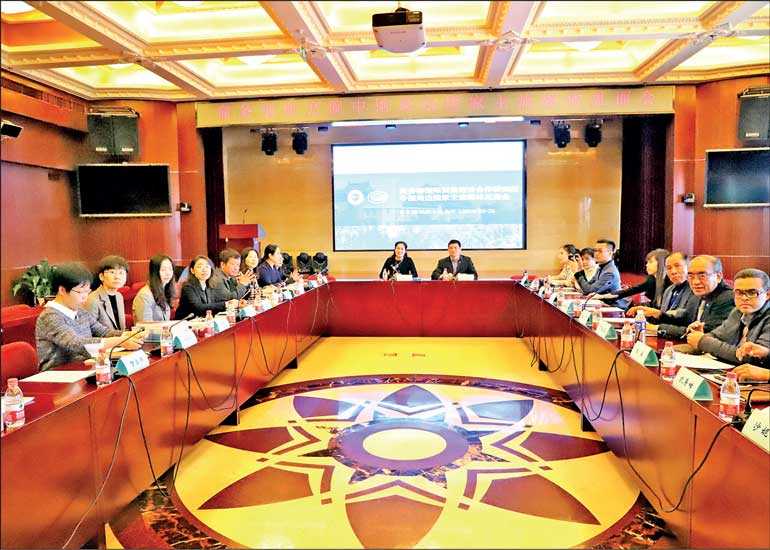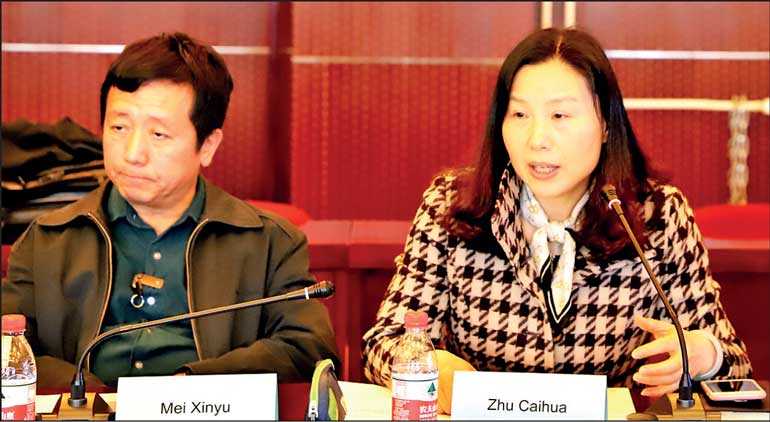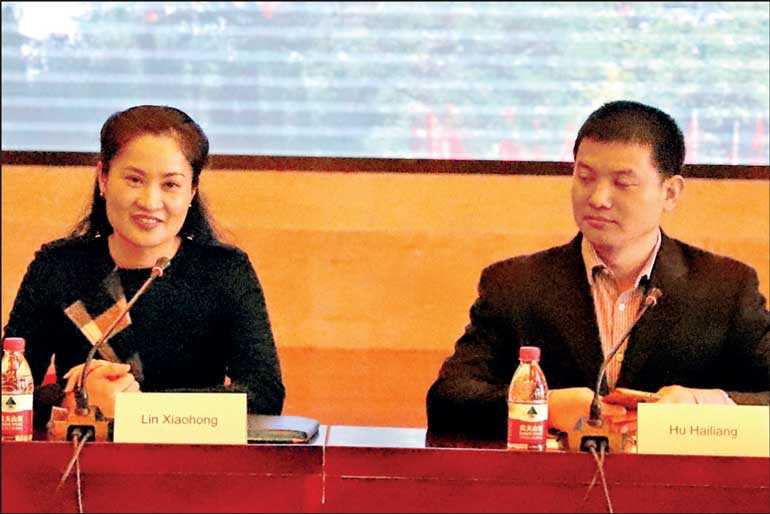Sunday Nov 23, 2025
Sunday Nov 23, 2025
Friday, 3 May 2019 00:00 - - {{hitsCtrl.values.hits}}



By Shanika Sriyananda in Beijing
A top Chinese researcher in international trade claimed that developing countries, including Sri Lanka, which had taken loans from China, were not caught in a so-called ‘debt trap’ but were in a ‘trap’ created by forces with bad intentions to mislead them.
She said that in the countries like Pakistan, Sri Lanka or Kenya, Chinese debt was not the major source in their debt composition and most importantly they had used that debt to improve their infrastructure, including highways and railways.
“It is very clear that Chinese loans and grants have really helped them to grow rather than just trap them,” Prof.
Zhu Caihua said.
Chinese Academy of International Trade and Economic Cooperation (CAITEC) Institute of International Trade Deputy Director Prof. Caihua at a meeting held in Beijing with journalists from Sri Lanka, Nepal, Pakistan, Myanmar, Mongolia, Philippines and Singapore, said that the US had huge debts and had borrowed a lot from China while claiming Chinese loans were ‘a trap’.
The ‘debt trap’ issue became a hot topic among other topics related to trade and economy among the views shared by the researchers representing the academy’s Asian Department, Foreign Trade Department, Trade Department and BRI Department, held at the CAITEC’s unique ‘palace-like’ headquarters located next to the Temple of Earth Park with a garden-like compound.
“They have used our money to invest in their economy, so I do not think it is a trap because it will help economies which lack finances to overcome their financial status. Therefore debt is a good tool,” she, who visited Pakistan, Sri Lanka and Nepal last year on a fact-finding tour, said.
Emphasising on the importance of having a good understanding between China and its neighbouring countries about their future, Prof. Caihua said that China was building new trade partnership models with underdeveloped neighbours on the basis of quality and mutual benefits, giving special and different consideration to developing countries.
During the International Import Expo – 2018, which was held for the first time in China, neighbouring countries and least developing countries were given preference following China’s methodology, which has a more practical stance.
BRI, a package of comprehensive trade tools
“China’s new partnership model goes far beyond trade. China is more concerned about loopholes such as lack of infrastructure investment and marginalising developing countries in the globalisation process. Poor access to the outside world due to lack of infrastructure facilities is the main reason for them to become marginalised and lagging far behind in the globalisation process,” she opined.
Prof. Caihua explaining the motive of China to develop the ‘Belt and Road Initiative’ (BRI) said that it was a package of comprehensive trade tools and did not only put emphasis on trade investment but also infrastructure and people-to-people exchange.
“The logic behind this initiative is China wants to help developing countries to develop better and have better connectivity. If they are connected to the rest of the world they can get involved in international trade. The first important step under BRI is to assist developing countries to build infrastructure through joint efforts and also to contribute with China’s technology, investment and other resources,” she said, adding that China also wanted other developing countries to join the BRI to build infrastructure to improve the quality of people’s lives in their countries.
According to Prof. Caihua, China had placed much emphasis on industrial cooperation to improve industrial productivity of developing countries under the BRI. “When the developing countries get connected globally, they can produce their products for international markets. China has opened tis markets for developing countries. Last year, we gave them more opportunities to sell their products to China,” she said.
The ASEAN e-Commerce Forum was launched in 2015 and has already helped many SMEs in Malaysia, Thailand and other ASEAN countries to sell their products to Chinese markets.
“This trade model is significantly different from other partnerships with developing and developed countries as new trading technology like e-commerce has been incorporated in this partnership. I believe more of the neighbouring countries will make use of this platform to sell their goods and services to China in future,” she noted.
Explaining how China overcame the economic crisis in the past, Prof. Caihua said that in early stages they depended heavily on debts from Western countries and international financial institutions and those debts had helped China to grow.
“In the past China depended extensively on imports, mainly labour, but later realised that model cannot be sustained in the future and then we had to transform from over-dependency on imports to innovation on land and roads,” she said.
CAITEC, with a history of over 70 years, is an inter-disciplinary and multifunctional institution of social science research and a consultative body directly under China’s Ministry of Commerce of China, engaged in research, information consultancy, publishing, education and training.
Internationally-acclaimed CAITEC has been recognised as one of the most influential think tanks in economic and trade research in China, with a competent research team and numerous achievements.
CAITEC Public Office Director Lin Xiaohong said that the four main functions of the institute were training and research, media communication and training and education.
“It covers 18 trade aspects and there are over 230 experts on economy and trade and over 100 experts and professionals doing their research overseas designated by the academy,” she said.
Reforms to overcome debt crisis
CAITEC Institute of International Trade Senior Researcher in Economics Dr. Mei Xinya said that when China was in a serious debt crisis, newly-introduced reforms which used the strategy of interventions instead of directly spending from capital had helped to overcome the situation.
“We transferred from borrowing to increasing Foreign Direct Investment. Within several years, China became the largest country with foreign capital and investments. We have successfully managed our issues to overcome the country’s huge debt crisis,” he claimed.
Dr. Xinya said that the then Chinese leader, who had realised that foreign debt at low cost and debt financing which were popular were not feasible or effective in the 1980s, had tightened the currency flow and it was replaced by the more beneficial policy towards foreign investments.
“The first decade of the 21st century had rapid growth in the world economy, the tightening policy towards foreign capital may have relatively invisible effects in foreign trade. However, now it is time that we have our foreign trade policy in order to develop foreign trade and economy.”
He said that China had a preferential policy towards Foreign Direct Investments for Sri Lanka, Nepal, Pakistan, Mongolia, Mynmar, Philippines and Singapore and the Government had passed the new Foreign Investment Law in 2019 in order to maintain China’s competition in international markets.
“These reforms have helped China improve our foreign trade environment and improve our foreign capitals by 30% and also the foreign capital flow was down by 19% worldwide. We are sharing these experiences with our trade partners and to attract foreign investments we have make sure that capitals are profitable to investors,” he said, adding that during the early years of the BRI, it had raised the policy to empower foreign investments to make sure that the foreign investors had more cost effective policies than the domestic ones.
Largest capital economy
“Our story of reforms has inspired to increase foreign investments. China, which has the largest capital economy for foreign investments, has focused to improve the policy of foreign investments constantly. We are going to become the business model of the world and the growing investor for foreign countries, soon. Therefore, foreign countries including neighbouring countries will have opportunities to improve their foreign capitals, environment and improve competition in foreign trade,” Dr. Xinya explained.
He said that in terms of foreign investments, China was a very willing investor for neighbouring countries and they hoped their trade partners and other countries would have better business environment for foreign business.
“Overwhelming Western opinion thinks that China has set up a debt trap for many neighbouring countries. However, China’s foreign capital reserves, the parties and economies will leave a question for all of us to think of the credibility of this argument, which has many doubts itself. The facts and the real development will prove whether it is holding water for all of us to think about this argument again and focus on the real benefits of our development,” he stressed.
Although China is now the world’s largest foreign reserves nation, it was in a serious debt crisis and in the 1980s China’s foreign reserves were only sufficient for a few days for foreign trade, he said.
“To overcome payment pressure, China had to get loans from foreign financial institutions for high loan rate of 15% and had to be paid within six months,” Dr. Xinyu said.
Under BRI, China which has the second largest economy in the world wants to help the world economy, trade and promote common growth and while helping its neighbouring countries to overcome trade and economic related difficulties, he said.
Explaining how China, which was an underdeveloped state in 1950s, overcame its economic difficulties and later provided support for other countries in their national economic development, researcher in Chinese aid and International Development Cooperation Liu Xian said that since 2013, over 300 Chinese funded mega projects had assisted developing countries to improve culture, education, healthcare, industries and transportation.
Speaking on the present situation on Chinese foreign aid, she said over the past 60 years China’s foreign aid provided during international economic crisis situations had improved their ideas and policies, gained long-term development and achieved significant results.
China’s foreign aid growth
“Especially in 2013, China’s foreign aid grew steadily with diversified projects. Among the Chinese founded projects, there are over 2,000 livelihood programs given in different sectors and they have built schools, hospitals, water systems and poverty alleviation projects. Over 5,000 training programs in China have been offered to over 30,000 foreign experts in all areas and also trained over 300 youth volunteers in developing countries. China has provided 177 emergency aid to countries and international agencies and established international help programs to mitigate food crisis and refugee issues,” she said, spelling out facts and figures of Chinese foreign aided programs.
Xian said that in April 2018, China had introduced institutional reforms to establish an international cooperation development institution focusing on managing its foreign aid process. “It has brought significant reform process in China’s foreign aid, which will continue to offer to developing countries for their national developments and also to serve the national diplomacy to contribute for humanity in future,” she said while highlighting the ‘debt trap’ claim.
She opined that developing countries needed huge amounts of capital for infrastructure development for their economic growth but were facing severe financial crises and most of them were largely dependent on support of many international financial institutions to get support for their development projects.
“The Chinese funded projects for developing countries have visible effects and have shown progress as they have built large ports, airports, rail roads and highways with our money. China also has industrial cooperation with them creating employment opportunities and economic development, which is locally bring actual benefits to their people and societies,” Xian said, adding that China was always concerned about the sustainability of their projects and gives training to local people to take the projects forward and also to encourage local businesses.
Economic boost under BRI
“We have held many foreign aid training programs for the major cooperation projects. In 2018, we held port management training for Sri Lankan experts in port management to study China’s system of port management,” she noted.
Researcher at the Institute of Economic and Trade Cooperation under BRI Qi Xin explaining how developing countries experience an economic boost under BRI revealed that from 2013 to 2018 China’s trade goods to neighbouring countries under BRI had increased significantly from $ 14,000 million to $ 127,000 million.
“The total trade volume has grown from 25% to 27.4%, while cross border e-commerce has become a newly-developed popular slot for trade development in developing countries. From 2013 to 2018 China’s railway connectivity had grown connecting 15 countries and 50 cities and they had become very important platforms for national cooperation, connectivity, improving e-connectivity and trade and cooperation,” she asserted.
From 2013 to 2018 China’s trade goods to neighbouring countries under BRI increased significantly from $ 14,000 m to $ 127,000. Total trade volume has grown from 25% to 27.4% with cross border e-commerce becoming a newly developed popular slot for trade development.
From 2013 to 2018, China’s railway connectivity with Europe had 13,000 trains connecting 15 countries and 50 cities and they had become very important platforms for national cooperation, connectivity, improving e-connectivity and trade and cooperation.
Xin said that coastal economic cooperation has become a major areas in China’s cooperation with neighbouring countries under the BRI. “From 2013 to 2018, China contracted programs with neighbouring countries reached $ 90 billion with an increase by 6.2%,” she revealed, giving more statistical evidence to prove that China’s financial support had helped its neighbours to develop their economies.
According to Xin, China has established 82 free trade zones in neighbouring countries and invested over $ 36.48 billion, over 64,000 offices had been set up by Chinese companies in those countries and the tax that they contribute reached $ 2.4 billion and created over 265,000 employment opportunities to improve social development and upgrading industries in its neighbouring countries.
“From 2013 to 2018 China contracted projects had increased by 11.8% competing yearly growth of 6.4%. Improving information communication, China has successfully established a basic satellite system providing GPS services for BRI countries using 19 satellites. Laos and Myanmar have become China’s main international users of this satellite system for natural disaster prevention and protection,” he explained.